YOLOv5改进 | 2023主干篇 | RepViT从视觉变换器(ViT)的视角重新审视CNN
?一、本文介绍
本文给大家来的改进机制是RepViT,用其替换我们整个主干网络,其是今年最新推出的主干网络,其主要思想是将轻量级视觉变换器(ViT)的设计原则应用于传统的轻量级卷积神经网络(CNN)。我将其替换整个YOLOv5的Backbone,实现了大幅度涨点。我对修改后的网络(我用的最轻量的版本),在一个包含1000张图片包含大中小的检测目标的数据集上(共有20+类别),进行训练测试,发现所有的目标上均有一定程度的涨点效果,下面我会附上基础版本和修改版本的训练对比图。
推荐指数:?????
训练结果对比图->???
(有效性先用YOLOv8上的实验对比,后期会给大家补上)

目录
二、RepViT基本原理

?
官方论文地址:?官方论文地址点击即可跳转
官方代码地址:?官方代码地址点击即可跳转

??
RepViT: Revisiting Mobile CNN From ViT Perspective 这篇论文探讨了如何改进轻量级卷积神经网络(CNN)以提高其在移动设备上的性能和效率。作者们发现,虽然轻量级视觉变换器(ViT)因其能够学习全局表示而表现出色,但轻量级CNN和轻量级ViT之间的架构差异尚未得到充分研究。因此,他们通过整合轻量级ViT的高效架构设计,逐步改进标准轻量级CNN(特别是MobileNetV3),从而创造了一系列全新的纯CNN模型,称为RepViT。这些模型在各种视觉任务上表现出色,比现有的轻量级ViT更高效。
其主要的改进机制包括:
-
结构性重组:通过结构性重组(Structural Re-parameterization, SR),引入多分支拓扑结构,以提高训练时的性能。
-
扩展比率调整:调整卷积层中的扩展比率,以减少参数冗余和延迟,同时提高网络宽度以增强模型性能。
-
宏观设计优化:对网络的宏观架构进行优化,包括早期卷积层的设计、更深的下采样层、简化的分类器,以及整体阶段比例的调整。
-
微观设计调整:在微观架构层面进行优化,包括卷积核大小的选择和压缩激励(SE)层的最佳放置。
这些创新机制共同推动了轻量级CNN的性能和效率,使其更适合在移动设备上使用,下面的是官方论文中的结构图,我们对其进行简单的分析。
 ?
?
这张图片是论文中的图3,展示了RepViT架构的总览。RepViT有四个阶段,输入图像的分辨率依次为
 ?
?
每个阶段的通道维度用 Ci? 表示,批处理大小用 B 表示。?
- Stem:用于预处理输入图像的模块。
- Stage1-4:每个阶段由多个RepViTBlock组成,以及一个可选的RepViTSEBlock,包含深度可分离卷积(3x3DW),1x1卷积,压缩激励模块(SE)和前馈网络(FFN)。每个阶段通过下采样减少空间维度。
- Pooling:全局平均池化层,用于减少特征图的空间维度。
- FC:全连接层,用于最终的类别预测。
?总结:大家可以将RepViT看成是MobileNet系列的改进版本
三、RepViT的核心代码?
下面的代码是整个RepViT的核心代码,其中有个版本,对应的GFLOPs也不相同,使用方式看章节四。
import torch.nn as nn
from timm.models.layers import SqueezeExcite
import torch
__all__ = ['repvit_m0_6','repvit_m0_9', 'repvit_m1_0', 'repvit_m1_1', 'repvit_m1_5', 'repvit_m2_3']
def _make_divisible(v, divisor, min_value=None):
"""
This function is taken from the original tf repo.
It ensures that all layers have a channel number that is divisible by 8
It can be seen here:
https://github.com/tensorflow/models/blob/master/research/slim/nets/mobilenet/mobilenet.py
:param v:
:param divisor:
:param min_value:
:return:
"""
if min_value is None:
min_value = divisor
new_v = max(min_value, int(v + divisor / 2) // divisor * divisor)
# Make sure that round down does not go down by more than 10%.
if new_v < 0.9 * v:
new_v += divisor
return new_v
class Conv2d_BN(torch.nn.Sequential):
def __init__(self, a, b, ks=1, stride=1, pad=0, dilation=1,
groups=1, bn_weight_init=1, resolution=-10000):
super().__init__()
self.add_module('c', torch.nn.Conv2d(
a, b, ks, stride, pad, dilation, groups, bias=False))
self.add_module('bn', torch.nn.BatchNorm2d(b))
torch.nn.init.constant_(self.bn.weight, bn_weight_init)
torch.nn.init.constant_(self.bn.bias, 0)
@torch.no_grad()
def fuse_self(self):
c, bn = self._modules.values()
w = bn.weight / (bn.running_var + bn.eps) ** 0.5
w = c.weight * w[:, None, None, None]
b = bn.bias - bn.running_mean * bn.weight / \
(bn.running_var + bn.eps) ** 0.5
m = torch.nn.Conv2d(w.size(1) * self.c.groups, w.size(
0), w.shape[2:], stride=self.c.stride, padding=self.c.padding, dilation=self.c.dilation,
groups=self.c.groups,
device=c.weight.device)
m.weight.data.copy_(w)
m.bias.data.copy_(b)
return m
class Residual(torch.nn.Module):
def __init__(self, m, drop=0.):
super().__init__()
self.m = m
self.drop = drop
def forward(self, x):
if self.training and self.drop > 0:
return x + self.m(x) * torch.rand(x.size(0), 1, 1, 1,
device=x.device).ge_(self.drop).div(1 - self.drop).detach()
else:
return x + self.m(x)
@torch.no_grad()
def fuse_self(self):
if isinstance(self.m, Conv2d_BN):
m = self.m.fuse_self()
assert (m.groups == m.in_channels)
identity = torch.ones(m.weight.shape[0], m.weight.shape[1], 1, 1)
identity = torch.nn.functional.pad(identity, [1, 1, 1, 1])
m.weight += identity.to(m.weight.device)
return m
elif isinstance(self.m, torch.nn.Conv2d):
m = self.m
assert (m.groups != m.in_channels)
identity = torch.ones(m.weight.shape[0], m.weight.shape[1], 1, 1)
identity = torch.nn.functional.pad(identity, [1, 1, 1, 1])
m.weight += identity.to(m.weight.device)
return m
else:
return self
class RepVGGDW(torch.nn.Module):
def __init__(self, ed) -> None:
super().__init__()
self.conv = Conv2d_BN(ed, ed, 3, 1, 1, groups=ed)
self.conv1 = torch.nn.Conv2d(ed, ed, 1, 1, 0, groups=ed)
self.dim = ed
self.bn = torch.nn.BatchNorm2d(ed)
def forward(self, x):
return self.bn((self.conv(x) + self.conv1(x)) + x)
@torch.no_grad()
def fuse_self(self):
conv = self.conv.fuse_self()
conv1 = self.conv1
conv_w = conv.weight
conv_b = conv.bias
conv1_w = conv1.weight
conv1_b = conv1.bias
conv1_w = torch.nn.functional.pad(conv1_w, [1, 1, 1, 1])
identity = torch.nn.functional.pad(torch.ones(conv1_w.shape[0], conv1_w.shape[1], 1, 1, device=conv1_w.device),
[1, 1, 1, 1])
final_conv_w = conv_w + conv1_w + identity
final_conv_b = conv_b + conv1_b
conv.weight.data.copy_(final_conv_w)
conv.bias.data.copy_(final_conv_b)
bn = self.bn
w = bn.weight / (bn.running_var + bn.eps) ** 0.5
w = conv.weight * w[:, None, None, None]
b = bn.bias + (conv.bias - bn.running_mean) * bn.weight / \
(bn.running_var + bn.eps) ** 0.5
conv.weight.data.copy_(w)
conv.bias.data.copy_(b)
return conv
class RepViTBlock(nn.Module):
def __init__(self, inp, hidden_dim, oup, kernel_size, stride, use_se, use_hs):
super(RepViTBlock, self).__init__()
assert stride in [1, 2]
self.identity = stride == 1 and inp == oup
assert (hidden_dim == 2 * inp)
if stride == 2:
self.token_mixer = nn.Sequential(
Conv2d_BN(inp, inp, kernel_size, stride, (kernel_size - 1) // 2, groups=inp),
SqueezeExcite(inp, 0.25) if use_se else nn.Identity(),
Conv2d_BN(inp, oup, ks=1, stride=1, pad=0)
)
self.channel_mixer = Residual(nn.Sequential(
# pw
Conv2d_BN(oup, 2 * oup, 1, 1, 0),
nn.GELU() if use_hs else nn.GELU(),
# pw-linear
Conv2d_BN(2 * oup, oup, 1, 1, 0, bn_weight_init=0),
))
else:
assert (self.identity)
self.token_mixer = nn.Sequential(
RepVGGDW(inp),
SqueezeExcite(inp, 0.25) if use_se else nn.Identity(),
)
self.channel_mixer = Residual(nn.Sequential(
# pw
Conv2d_BN(inp, hidden_dim, 1, 1, 0),
nn.GELU() if use_hs else nn.GELU(),
# pw-linear
Conv2d_BN(hidden_dim, oup, 1, 1, 0, bn_weight_init=0),
))
def forward(self, x):
return self.channel_mixer(self.token_mixer(x))
class RepViT(nn.Module):
def __init__(self, cfgs):
super(RepViT, self).__init__()
# setting of inverted residual blocks
self.cfgs = cfgs
# building first layer
input_channel = self.cfgs[0][2]
patch_embed = torch.nn.Sequential(Conv2d_BN(3, input_channel // 2, 3, 2, 1), torch.nn.GELU(),
Conv2d_BN(input_channel // 2, input_channel, 3, 2, 1))
layers = [patch_embed]
# building inverted residual blocks
block = RepViTBlock
for k, t, c, use_se, use_hs, s in self.cfgs:
output_channel = _make_divisible(c, 8)
exp_size = _make_divisible(input_channel * t, 8)
layers.append(block(input_channel, exp_size, output_channel, k, s, use_se, use_hs))
input_channel = output_channel
self.features = nn.ModuleList(layers)
self.width_list = [i.size(1) for i in self.forward(torch.randn(1, 3, 640, 640))]
def forward(self, x):
# x = self.features(x
results = [None, None, None, None]
temp = None
i = None
for index, f in enumerate(self.features):
x = f(x)
if index == 0:
temp = x.size(1)
i = 0
elif x.size(1) == temp:
results[i] = x
else:
temp = x.size(1)
i = i + 1
return results
def repvit_m0_6():
"""
Constructs a MobileNetV3-Large model
"""
cfgs = [
[3, 2, 40, 1, 0, 1],
[3, 2, 40, 0, 0, 1],
[3, 2, 80, 0, 0, 2],
[3, 2, 80, 1, 0, 1],
[3, 2, 80, 0, 0, 1],
[3, 2, 160, 0, 1, 2],
[3, 2, 160, 1, 1, 1],
[3, 2, 160, 0, 1, 1],
[3, 2, 160, 1, 1, 1],
[3, 2, 160, 0, 1, 1],
[3, 2, 160, 1, 1, 1],
[3, 2, 160, 0, 1, 1],
[3, 2, 160, 1, 1, 1],
[3, 2, 160, 0, 1, 1],
[3, 2, 160, 0, 1, 1],
[3, 2, 320, 0, 1, 2],
[3, 2, 320, 1, 1, 1],
]
model = RepViT(cfgs)
return model
def repvit_m0_9():
"""
Constructs a MobileNetV3-Large model
"""
cfgs = [
# k, t, c, SE, HS, s
[3, 2, 48, 1, 0, 1],
[3, 2, 48, 0, 0, 1],
[3, 2, 48, 0, 0, 1],
[3, 2, 96, 0, 0, 2],
[3, 2, 96, 1, 0, 1],
[3, 2, 96, 0, 0, 1],
[3, 2, 96, 0, 0, 1],
[3, 2, 192, 0, 1, 2],
[3, 2, 192, 1, 1, 1],
[3, 2, 192, 0, 1, 1],
[3, 2, 192, 1, 1, 1],
[3, 2, 192, 0, 1, 1],
[3, 2, 192, 1, 1, 1],
[3, 2, 192, 0, 1, 1],
[3, 2, 192, 1, 1, 1],
[3, 2, 192, 0, 1, 1],
[3, 2, 192, 1, 1, 1],
[3, 2, 192, 0, 1, 1],
[3, 2, 192, 1, 1, 1],
[3, 2, 192, 0, 1, 1],
[3, 2, 192, 1, 1, 1],
[3, 2, 192, 0, 1, 1],
[3, 2, 192, 0, 1, 1],
[3, 2, 384, 0, 1, 2],
[3, 2, 384, 1, 1, 1],
[3, 2, 384, 0, 1, 1]
]
model = RepViT(cfgs)
return model
def repvit_m1_0():
"""
Constructs a MobileNetV3-Large model
"""
cfgs = [
# k, t, c, SE, HS, s
[3, 2, 56, 1, 0, 1],
[3, 2, 56, 0, 0, 1],
[3, 2, 56, 0, 0, 1],
[3, 2, 112, 0, 0, 2],
[3, 2, 112, 1, 0, 1],
[3, 2, 112, 0, 0, 1],
[3, 2, 112, 0, 0, 1],
[3, 2, 224, 0, 1, 2],
[3, 2, 224, 1, 1, 1],
[3, 2, 224, 0, 1, 1],
[3, 2, 224, 1, 1, 1],
[3, 2, 224, 0, 1, 1],
[3, 2, 224, 1, 1, 1],
[3, 2, 224, 0, 1, 1],
[3, 2, 224, 1, 1, 1],
[3, 2, 224, 0, 1, 1],
[3, 2, 224, 1, 1, 1],
[3, 2, 224, 0, 1, 1],
[3, 2, 224, 1, 1, 1],
[3, 2, 224, 0, 1, 1],
[3, 2, 224, 1, 1, 1],
[3, 2, 224, 0, 1, 1],
[3, 2, 224, 0, 1, 1],
[3, 2, 448, 0, 1, 2],
[3, 2, 448, 1, 1, 1],
[3, 2, 448, 0, 1, 1]
]
model = RepViT(cfgs)
return model
def repvit_m1_1():
"""
Constructs a MobileNetV3-Large model
"""
cfgs = [
# k, t, c, SE, HS, s
[3, 2, 64, 1, 0, 1],
[3, 2, 64, 0, 0, 1],
[3, 2, 64, 0, 0, 1],
[3, 2, 128, 0, 0, 2],
[3, 2, 128, 1, 0, 1],
[3, 2, 128, 0, 0, 1],
[3, 2, 128, 0, 0, 1],
[3, 2, 256, 0, 1, 2],
[3, 2, 256, 1, 1, 1],
[3, 2, 256, 0, 1, 1],
[3, 2, 256, 1, 1, 1],
[3, 2, 256, 0, 1, 1],
[3, 2, 256, 1, 1, 1],
[3, 2, 256, 0, 1, 1],
[3, 2, 256, 1, 1, 1],
[3, 2, 256, 0, 1, 1],
[3, 2, 256, 1, 1, 1],
[3, 2, 256, 0, 1, 1],
[3, 2, 256, 1, 1, 1],
[3, 2, 256, 0, 1, 1],
[3, 2, 256, 0, 1, 1],
[3, 2, 512, 0, 1, 2],
[3, 2, 512, 1, 1, 1],
[3, 2, 512, 0, 1, 1]
]
model = RepViT(cfgs)
return model
def repvit_m1_5():
"""
Constructs a MobileNetV3-Large model
"""
cfgs = [
# k, t, c, SE, HS, s
[3, 2, 64, 1, 0, 1],
[3, 2, 64, 0, 0, 1],
[3, 2, 64, 1, 0, 1],
[3, 2, 64, 0, 0, 1],
[3, 2, 64, 0, 0, 1],
[3, 2, 128, 0, 0, 2],
[3, 2, 128, 1, 0, 1],
[3, 2, 128, 0, 0, 1],
[3, 2, 128, 1, 0, 1],
[3, 2, 128, 0, 0, 1],
[3, 2, 128, 0, 0, 1],
[3, 2, 256, 0, 1, 2],
[3, 2, 256, 1, 1, 1],
[3, 2, 256, 0, 1, 1],
[3, 2, 256, 1, 1, 1],
[3, 2, 256, 0, 1, 1],
[3, 2, 256, 1, 1, 1],
[3, 2, 256, 0, 1, 1],
[3, 2, 256, 1, 1, 1],
[3, 2, 256, 0, 1, 1],
[3, 2, 256, 1, 1, 1],
[3, 2, 256, 0, 1, 1],
[3, 2, 256, 1, 1, 1],
[3, 2, 256, 0, 1, 1],
[3, 2, 256, 1, 1, 1],
[3, 2, 256, 0, 1, 1],
[3, 2, 256, 1, 1, 1],
[3, 2, 256, 0, 1, 1],
[3, 2, 256, 1, 1, 1],
[3, 2, 256, 0, 1, 1],
[3, 2, 256, 1, 1, 1],
[3, 2, 256, 0, 1, 1],
[3, 2, 256, 1, 1, 1],
[3, 2, 256, 0, 1, 1],
[3, 2, 256, 1, 1, 1],
[3, 2, 256, 0, 1, 1],
[3, 2, 256, 0, 1, 1],
[3, 2, 512, 0, 1, 2],
[3, 2, 512, 1, 1, 1],
[3, 2, 512, 0, 1, 1],
[3, 2, 512, 1, 1, 1],
[3, 2, 512, 0, 1, 1]
]
model = RepViT(cfgs)
return model
def repvit_m2_3():
"""
Constructs a MobileNetV3-Large model
"""
cfgs = [
# k, t, c, SE, HS, s
[3, 2, 80, 1, 0, 1],
[3, 2, 80, 0, 0, 1],
[3, 2, 80, 1, 0, 1],
[3, 2, 80, 0, 0, 1],
[3, 2, 80, 1, 0, 1],
[3, 2, 80, 0, 0, 1],
[3, 2, 80, 0, 0, 1],
[3, 2, 160, 0, 0, 2],
[3, 2, 160, 1, 0, 1],
[3, 2, 160, 0, 0, 1],
[3, 2, 160, 1, 0, 1],
[3, 2, 160, 0, 0, 1],
[3, 2, 160, 1, 0, 1],
[3, 2, 160, 0, 0, 1],
[3, 2, 160, 0, 0, 1],
[3, 2, 320, 0, 1, 2],
[3, 2, 320, 1, 1, 1],
[3, 2, 320, 0, 1, 1],
[3, 2, 320, 1, 1, 1],
[3, 2, 320, 0, 1, 1],
[3, 2, 320, 1, 1, 1],
[3, 2, 320, 0, 1, 1],
[3, 2, 320, 1, 1, 1],
[3, 2, 320, 0, 1, 1],
[3, 2, 320, 1, 1, 1],
[3, 2, 320, 0, 1, 1],
[3, 2, 320, 1, 1, 1],
[3, 2, 320, 0, 1, 1],
[3, 2, 320, 1, 1, 1],
[3, 2, 320, 0, 1, 1],
[3, 2, 320, 1, 1, 1],
[3, 2, 320, 0, 1, 1],
[3, 2, 320, 1, 1, 1],
[3, 2, 320, 0, 1, 1],
[3, 2, 320, 1, 1, 1],
[3, 2, 320, 0, 1, 1],
[3, 2, 320, 1, 1, 1],
[3, 2, 320, 0, 1, 1],
[3, 2, 320, 1, 1, 1],
[3, 2, 320, 0, 1, 1],
[3, 2, 320, 1, 1, 1],
[3, 2, 320, 0, 1, 1],
[3, 2, 320, 1, 1, 1],
[3, 2, 320, 0, 1, 1],
[3, 2, 320, 1, 1, 1],
[3, 2, 320, 0, 1, 1],
[3, 2, 320, 1, 1, 1],
[3, 2, 320, 0, 1, 1],
[3, 2, 320, 1, 1, 1],
[3, 2, 320, 0, 1, 1],
# [3, 2, 320, 1, 1, 1],
# [3, 2, 320, 0, 1, 1],
[3, 2, 320, 0, 1, 1],
[3, 2, 640, 0, 1, 2],
[3, 2, 640, 1, 1, 1],
[3, 2, 640, 0, 1, 1],
# [3, 2, 640, 1, 1, 1],
# [3, 2, 640, 0, 1, 1]
]
model = RepViT(cfgs)
return model
四、手把手教你添加RepViT网络结构
这个主干的网络结构添加起来算是所有的改进机制里最麻烦的了,因为有一些网略结构可以用yaml文件搭建出来,有一些网络结构其中的一些细节根本没有办法用yaml文件去搭建,用yaml文件去搭建会损失一些细节部分(而且一个网络结构设计很多细节的结构修改方式都不一样,一个一个去修改大家难免会出错),所以这里让网络直接返回整个网络,然后修改部分 yolo代码以后就都以这种形式添加了,以后我提出的网络模型基本上都会通过这种方式修改,我也会进行一些模型细节改进。创新出新的网络结构大家直接拿来用就可以的。下面开始添加教程->
(同时每一个后面都有代码,大家拿来复制粘贴替换即可,但是要看好了不要复制粘贴替换多了)
修改一
我们复制网络结构代码到“yolov5-master/models”目录下创建一个目录,我这里的名字是modules(如果将文件放在models下面随着改进机制越来越多不太好区分,所以创建一个文件目录将改进机制全部放在里面)?,然后创建一个py文件将代码复制粘贴到里面我这里起的名字是RepViT。

?
修改二
然后我们在我们创建的目录里面创建一个初始化文件'__init__.py',然后在里面导入我们同级目录的所有改进机制
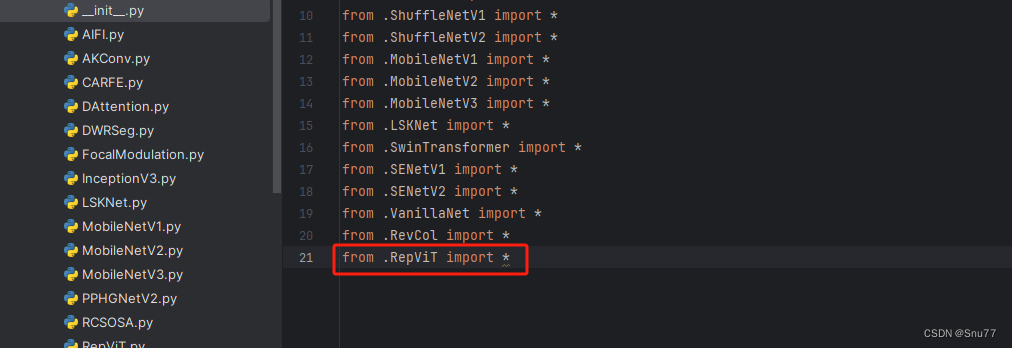 ??
??
修改三
我们找到如下文件'models/yolo.py'在开头里面导入我们的模块,这里需要注意要将代码放在common导入的文件上面,否则有一些模块会使用我们modules里面的,可能同名导致报错,这里如果你使用多个我的改进机制填写一个即可,不用重复添加。

修改四
添加如下两行代码,根据行数找相似的代码进行添加

修改五
找到七百多行大概把具体看图片,按照图片来修改就行,添加红框内的部分,注意没有()只是函数名,我这里只添加了部分的版本,大家有兴趣这个RepViT还有更多的版本可以添加,看我给的代码函数头即可。

elif m in {自行添加对应的模型即可,下面都是一样的}:
m = m()
c2 = m.width_list # 返回通道列表
backbone = True修改五?
下面的两个红框内都是需要改动的。?
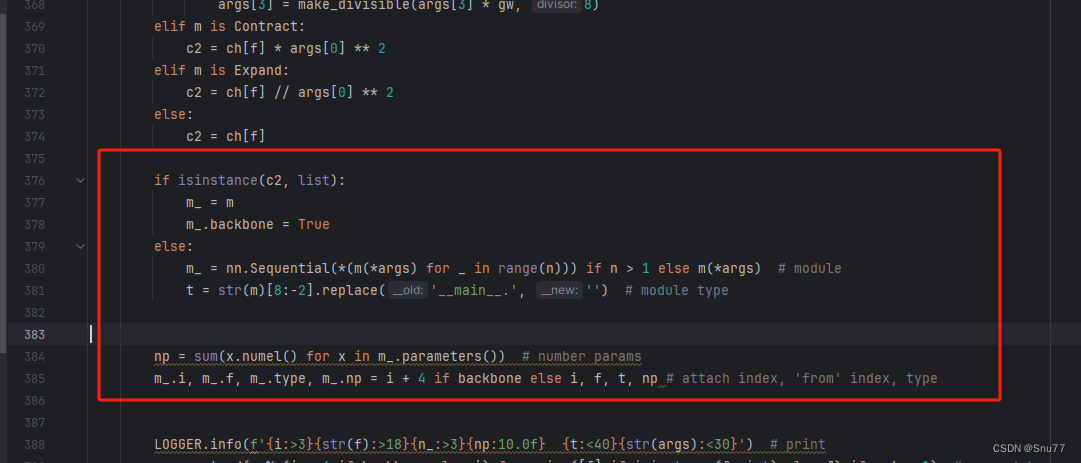
if isinstance(c2, list):
m_ = m
m_.backbone = True
else:
m_ = nn.Sequential(*(m(*args) for _ in range(n))) if n > 1 else m(*args) # module
t = str(m)[8:-2].replace('__main__.', '') # module type
np = sum(x.numel() for x in m_.parameters()) # number params
m_.i, m_.f, m_.type, m_.np = i + 4 if backbone else i, f, t, np # attach index, 'from' index, type修改六?
如下的也需要修改,全部按照我的来。
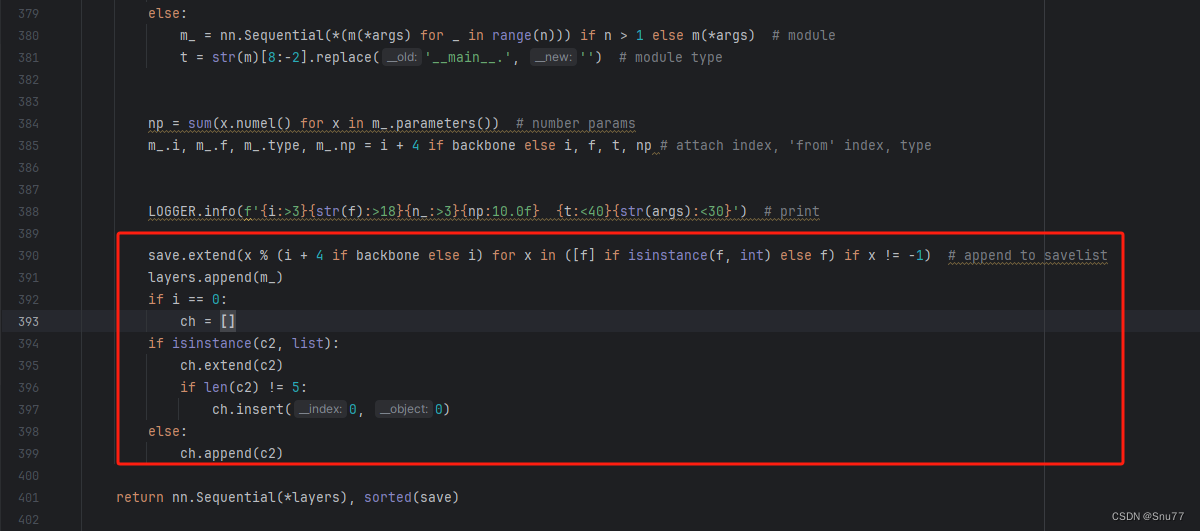
代码如下把原先的代码替换了即可。?
save.extend(x % (i + 4 if backbone else i) for x in ([f] if isinstance(f, int) else f) if x != -1) # append to savelist
layers.append(m_)
if i == 0:
ch = []
if isinstance(c2, list):
ch.extend(c2)
if len(c2) != 5:
ch.insert(0, 0)
else:
ch.append(c2)修改七
修改七和前面的都不太一样,需要修改前向传播中的一个部分,?已经离开了parse_model方法了。
可以在图片中开代码行数,没有离开task.py文件都是同一个文件。 同时这个部分有好几个前向传播都很相似,大家不要看错了,是70多行左右的!!!,同时我后面提供了代码,大家直接复制粘贴即可,有时间我针对这里会出一个视频。
找到如下的代码,这里不太好找,我给大家上传一个原始的样子。
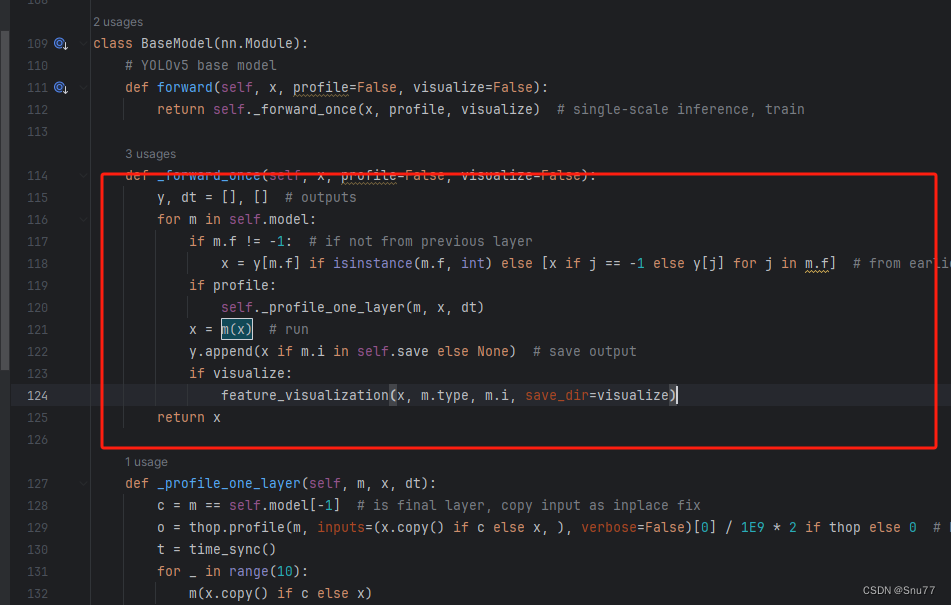
然后我们用后面的代码进行替换,替换完之后的样子如下->?
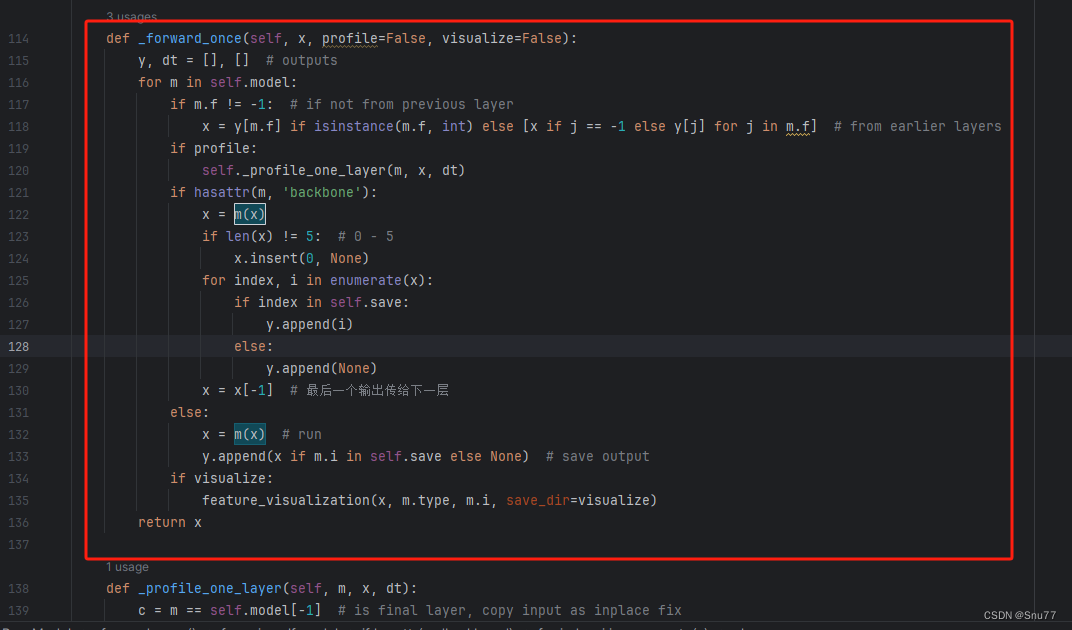 ??
??
代码如下->
def _forward_once(self, x, profile=False, visualize=False):
y, dt = [], [] # outputs
for m in self.model:
if m.f != -1: # if not from previous layer
x = y[m.f] if isinstance(m.f, int) else [x if j == -1 else y[j] for j in m.f] # from earlier layers
if profile:
self._profile_one_layer(m, x, dt)
if hasattr(m, 'backbone'):
x = m(x)
if len(x) != 5: # 0 - 5
x.insert(0, None)
for index, i in enumerate(x):
if index in self.save:
y.append(i)
else:
y.append(None)
x = x[-1] # 最后一个输出传给下一层
else:
x = m(x) # run
y.append(x if m.i in self.save else None) # save output
if visualize:
feature_visualization(x, m.type, m.i, save_dir=visualize)
return x到这里就完成了修改部分,但是这里面细节很多,大家千万要注意不要替换多余的代码,导致报错,也不要拉下任何一部,都会导致运行失败,而且报错很难排查!!!很难排查!!!?
五、RepViT的yaml文件
复制如下yaml文件进行运行!!!?
# YOLOv5 🚀 by Ultralytics, AGPL-3.0 license
# Parameters
nc: 80 # number of classes
depth_multiple: 0.33 # model depth multiple
width_multiple: 0.25 # layer channel multiple
anchors:
- [10,13, 16,30, 33,23] # P3/8
- [30,61, 62,45, 59,119] # P4/16
- [116,90, 156,198, 373,326] # P5/32
backbone:
# [from, number, module, args]
[[-1, 1, repvit_m0_6, []], # 0-4-P1/
[-1, 1, SPPF, [1024, 5]], # 5
]
# YOLOv5 v6.0 head
head:
[[-1, 1, Conv, [512, 1, 1]],
[-1, 1, nn.Upsample, [None, 2, 'nearest']],
[[-1, 3], 1, Concat, [1]], # cat backbone P4
[-1, 3, C3, [512, False]], # 9
[-1, 1, Conv, [256, 1, 1]],
[-1, 1, nn.Upsample, [None, 2, 'nearest']],
[[-1, 2], 1, Concat, [1]], # cat backbone P3
[-1, 3, C3, [256, False]], # 13 (P3/8-small)
[-1, 1, Conv, [256, 3, 2]],
[[-1, 9], 1, Concat, [1]], # cat head P4
[-1, 3, C3, [512, False]], # 16 (P4/16-medium)
[-1, 1, Conv, [512, 3, 2]],
[[-1, 5], 1, Concat, [1]], # cat head P5
[-1, 3, C3, [1024, False]], # 19 (P5/32-large)
[[13, 16, 19], 1, Detect, [nc, anchors]], # Detect(P3, P4, P5)
]
六、成功运行记录?
下面是成功运行的截图,已经完成了有1个epochs的训练,图片太大截不全第2个epochs了。?
 ?
?
??
七、本文总结
到此本文的正式分享内容就结束了,在这里给大家推荐我的YOLOv5改进有效涨点专栏,本专栏目前为新开的平均质量分97分,后期我会根据各种最新的前沿顶会进行论文复现,也会对一些老的改进机制进行补充,目前本专栏免费阅读(暂时,大家尽早关注不迷路~),如果大家觉得本文帮助到你了,订阅本专栏,关注后续更多的更新~
 ?
?
本文来自互联网用户投稿,该文观点仅代表作者本人,不代表本站立场。本站仅提供信息存储空间服务,不拥有所有权,不承担相关法律责任。 如若内容造成侵权/违法违规/事实不符,请联系我的编程经验分享网邮箱:veading@qq.com进行投诉反馈,一经查实,立即删除!